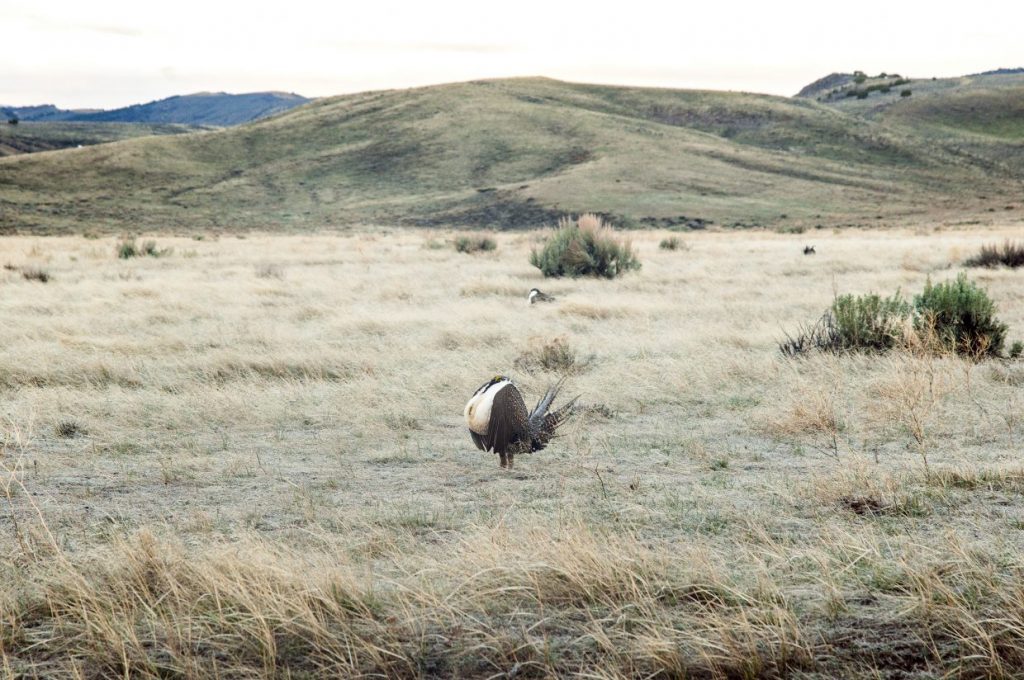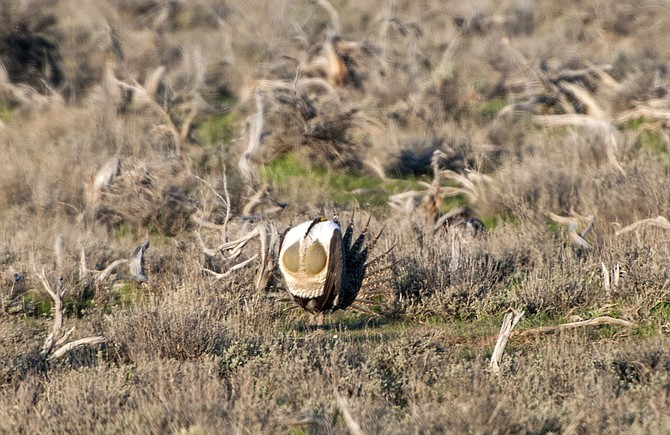Moffat County is home to 70 percent of Colorado’s sage grouse population, and is suing the Department of Interior alongside Garfield, Rio Blanco and Jackson counties over the Bureau of Land Management’s 2015 sage grouse management plan. Officials argue that the BLM violated federal regulations in the process of forming the plan by not properly including input from local governments and accounting for economic hardships created by the regulations.
Lauren Blair
Five years after sitting down at the table with the Bureau of Land Management to draw up a new sage grouse management plan, four Northwest Colorado counties are suing the U.S. Department of the Interior for what they believe was a faulty process with a predetermined outcome.
The BLM’s sage grouse plan, completed in 2015, is skewed heavily towards conservation, local officials say, while not allowing for balanced resource development or land use. In other words, protections for sage grouse are threatening to cripple local economies, they claim.

“The seriousness of this is unbelievable,” said Moffat County Commissioner Frank Moe in a May 9 meeting. “With all this work, all the diligence that’s been done, we’re fighting for our economic future.”
And as if to add irony to injury, while commissioners bite their fingernails about the county’s prospects, the birds are thriving, in part thanks to decades of work by ranchers and government agencies to preserve and improve their habitat.
“Last spring, our grouse counts were the highest they’ve ever been in 50 or 60 years of monitoring,” said Colorado Parks & Wildlife biologist Brian Holmes.
Garfield County is leading the litigatory charge, and will foot the largest portion of the bill with its substantial oil and gas revenues. Moffat County, home to about 70 percent of Colorado’s greater sage grouse population, also joined the lawsuit along with Rio Blanco and Jackson counties.
The three latter counties have each agreed to contribute $5,000 towards the cost of litigation.
“We exhausted our administrative options, and we’re left with no other choice but to bring litigation forward,” said Moffat County Natural Resources Director Jeff Comstock, citing years of weekly cooperative agency meetings and multiple protest letters throughout the plan’s formation.
Filed May 12 with the U.S. District Court, the lawsuit alleges that the BLM violated federal regulatory procedures and didn’t sufficiently include input from the four counties and other local partners. It also suggests the Washington, D.C. BLM office overrode the work that was being carried out between local BLM offices and local governments.
[wp_ad_camp_3]
“The federal plans disregard and ignore the counties’ input and reflect virtually none of the efforts, experience or local conditions documented by the counties,” the complaint said.
BLM does not comment on litigation and therefore declined to respond.
The complaint also provides a U.S. Geological Survey estimate that 66 trillion cubic feet of natural gas sits under Northwest Colorado, and sage grouse management plans would have an estimated negative annual impact of $240.5 million to $584 million.
“The core basis of all this is we have a thriving population. We’re really proud of the way we’ve taken care of the birds,” Comstock said. “If our grouse populations were crashing… I think that would change the whole shape of what we’re advocating for.”
The lawsuit echoes a letter drafted by former Moffat County Commissioner Tom Grey on behalf of five counties and two conservation districts in 2012, only a few months after cooperating agency meetings began.
“BLM’s parameters directed from the Washington BLM office provide little opportunity for meaningful input from local governments,” the letter stated, and ” the alternatives BLM is considering do not balance the basic need of grouse conservation and social and economic growth within our jurisdiction.”
The lawsuit is substantiated by documents obtained by Garfield County through a Freedom of Information Act request to shed light on the BLM’s process. Garfield County had to sue to enforce its FOIA request.
“We feel there were violations of their procedures,” said Garfield County Commissioner Tom Jankovsky, adding that the lawsuit also challenges the science utilized in the plan and the mapping used to determine how and where regulations would be enacted.
Garfield has funded extensive scientific research to provide more accurate mapping of local sage grouse habitat. Officials from multiple counties have also been meeting with CPW over the past year to refine the habitat maps used by the BLM plans, but this month’s lawsuit draws a new line in the sand.
“The administrative restrictions on BLM lands are just as stringent as if the species had been listed (under the Endangered Species Act),” Jankovsky said. “We don’t want to start over, so we’re hoping we can just working out some changes to the (plan).”



